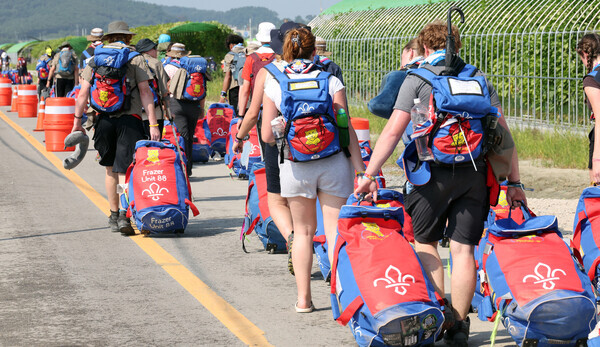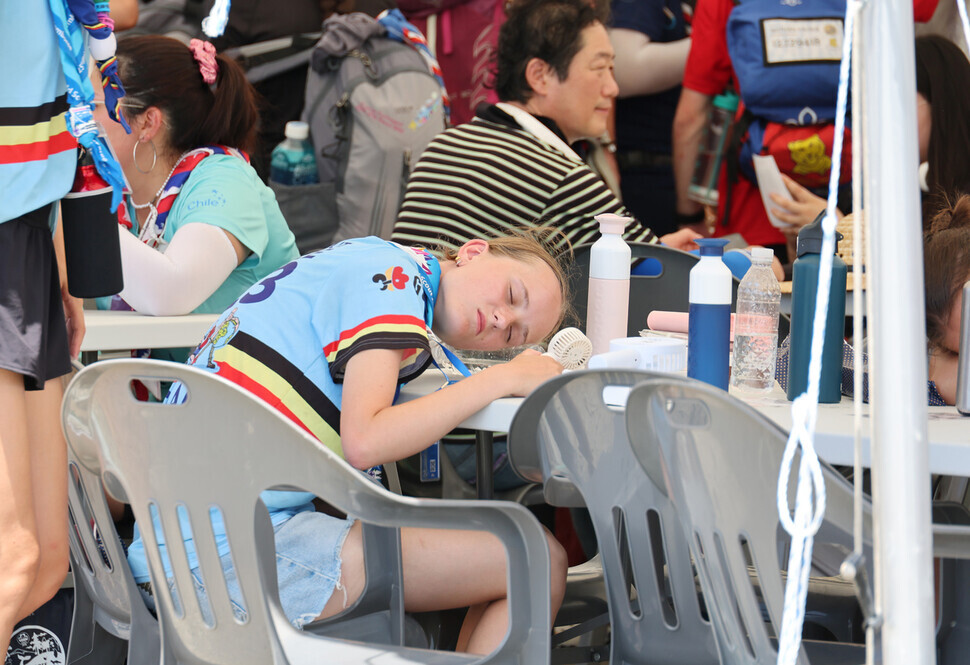hankyoreh
Links to other country sites 다른 나라 사이트 링크
Who’s at fault for Korea’s World Scout Jamboree fiasco?

“Given that the maximum August temperature at the host site can exceed 36℃, shaded rest areas will be provided through the installation of landscaping and facilities. [. . .] The plants that grow most effectively in reclaimed land will be planted throughout the Jamboree site to establish a richly forested space by 2023.”
Published in August 2018 by North Jeolla Province, “Report on the Results of the Bid for Saemangeum to Host the 25th World Scout Jamboree in 2023” painted an optimistic picture of the event. Sample images attached to the report showed camping tents situated amid a green site by the sea, with young people enjoying themselves under the shade of a profusion of vines.
But that rosy blueprint turned into a dismal reality.
With almost no natural shade available, jamboree participants have been exposed to the harsh rays of the sun. Their tents have been pitched not on greenery but on waterlogged earth.
As of Saturday, a total of 987 people had visited the infirmary on the gathering event site. Eighty-three of them were suffering from thermal injury, while 49 were treated for sunburn.
Inadequate measures for dealing with extreme heat, a flooded campsite, unhygienic bathrooms, moldy eggs — any one of these things would have been nearly impossible to imagine at an event where the national government had been actively involved.
In a briefing held a week before the scout gathering kicked off, Minister of Gender Equality and Family Kim Hyun-sook stressed on July 25 that the “most important thing is safety.” But a lack of safety measures was the reason cited by visiting groups from the UK and the US — the countries with the largest representation — when they pulled out of the event, leaving it a shell of what it had been.

The main factor cited in the jamboree fiasco has been the lack of any real “control tower.”
According to a special support law enacted for the 2023 Saemangeum World Scout Jamboree, the main office in charge of the event is the Ministry of Gender Equality and Family (MOGEF), which is responsible for policies related to young people. That law empowers the organizing committee to borrow funds, acquire items, and request the dispatching of government employees and a budget, contingent on approval from the Minister of Gender Equality and Family.
The problem has to do with the committee’s composition. The jamboree organizing committee has five directors in all.
Originally, two individuals were supposed to co-chair it: Kim Hyun-sook and Democratic Party lawmaker Kim Yun-duck (Jeonju-A, North Jeolla).
But the responsibilities ended up being dispersed even more last February when Minister of the Interior and Safety Lee Sang-min, Minister of Culture, Sports and Tourism Park Bo-gyoon, and Korea Scout Association President Kang Tae-sun were also appointed as co-chairs. The executive committee, which is responsible for practical activities, is chaired by North Jeolla Gov. Kim Kwan-young.
An official with the committee explained that it was a “collaborative system where the Ministry of the Interior and Safety (MOIS) was in charge of safety, the Ministry of Culture, Sports and Tourism (MCST) was responsible for publicity, and so on.”
“All five of them were co-chairs of the organizing committee, so it wasn’t the sort of thing where any one chairperson was the one assuming responsibility,” they added. In effect, the lack of one supervising committee chairperson created a system where each of the co-chairs could pass the buck when problems arose.
Even so, the MOGEF appears unlikely to duck charges of responsibility for the situation. The ministry had been involved in preparations since the committee’s launch in 2020, and the minister is granted the authority to approve budget allocation.
Indeed, some observers are saying Kim Hyun-sook is the one to blame for the situation. In particular, they have questioned whether she has been too focused on the push to eliminate the ministry since the beginning of her term to attend to the business that actually needed to be taken care of.
Some within the ministry expressed concerns that the jamboree disaster could lead to renewed calls for the MOGEF’s abolition.
Government ignored warningsThe need for stronger measures against intense heat and rainfall was cited during a parliamentary audit last October. In response, the government merely insisted over and over that the event would “proceed without problems.”
When the organizing committee requested an additional budget of 9.3 billion won (US$7.1 million) for measures against heavy rain and heat in early June, it ended up receiving just 2 billion won.
This half-hearted approach left the event ill-equipped to deal with the scale of problems it encountered.
After more and more participants suffered heat-related symptoms, the MOIS moved on Thursday to provide 3 billion won in emergency funds to the jamboree’s host province of North Jeolla through a special disaster safety subsidy. At an ad hoc Cabinet meeting called the following day, the decision was made to spend 6.9 billion in reserve funds on heat response measures (including air-conditioned buses) and necessary prevention items.
The MOGEF, for its part, spent 900 million won of its budget on handheld fans, headwear, and other supplies to distribute to jamboree participants.
Questions had been raised since the earliest stages on whether the reclaimed Saemangeum tidal flat was suitable for camping. The event’s setting is on land designated for agricultural purposes, where no large-scale drainage construction is possible.
In the Saemangeum framework plan, the site used for the jamboree was originally designated as being for tourism and leisure use, but it ended up being temporarily converted to agricultural use before its development. Since the arrangement was one in which the site had to be returned to its original condition once the event was over, no large-scale construction was possible.
Indeed, the event site ended up flooded by rainfall in May, three months before the jamboree was set to be held.
Commenting on the disruptions to the event caused by complacency and a lack of preparation, a full-time staff member for one North Jeolla-based environmental group said Sunday that it was “deeply unfortunate that the kids are the ones who suffer while the responsibility lies with the grown-ups.”
By Chai Yoon-tae, staff reporter; Yi Ju-been, staff reporter
Please direct questions or comments to [english@hani.co.kr]

Editorial・opinion
![[Column] How opposing war became a far-right policy [Column] How opposing war became a far-right policy](https://flexible.img.hani.co.kr/flexible/normal/500/300/imgdb/original/2024/0702/5017199091002075.jpg) [Column] How opposing war became a far-right policy
[Column] How opposing war became a far-right policy![[Editorial] Korea needs to adjust diplomatic course in preparation for a Trump comeback [Editorial] Korea needs to adjust diplomatic course in preparation for a Trump comeback](https://flexible.img.hani.co.kr/flexible/normal/500/300/imgdb/original/2024/0702/9717199086060096.jpg) [Editorial] Korea needs to adjust diplomatic course in preparation for a Trump comeback
[Editorial] Korea needs to adjust diplomatic course in preparation for a Trump comeback- [Editorial] Silence won’t save Yoon
- [Column] The miscalculations that started the Korean War mustn’t be repeated
- [Correspondent’s column] China-Europe relations tested once more by EV war
- [Correspondent’s column] Who really created the new ‘axis of evil’?
- [Editorial] Exploiting foreign domestic workers won’t solve Korea’s birth rate problem
- [Column] Kim and Putin’s new world order
- [Editorial] Workplace hazards can be prevented — why weren’t they this time?
- [Editorial] Seoul failed to use diplomacy with Moscow — now it’s resorting to threats
Most viewed articles
- 110 days of torture: Korean mental patient’s restraints only removed after death
- 2Nine dead in Seoul after car plows into pedestrians
- 3[Editorial] Korea needs to adjust diplomatic course in preparation for a Trump comeback
- 4[Column] How opposing war became a far-right policy
- 5Korea to create dedicated population strategy ministry to combat low birth rate, aging society
- 6Samsung Electronics workers to go on first strike in company’s 55-year history
- 7[Editorial] Silence won’t save Yoon
- 8Japan is building a military meant for more than self-defense — and has the US to thank for it
- 9Son Heung-min’s father, brother accused of child abuse at football academy
- 10Moscow tells Seoul to rethink ‘confrontational course’